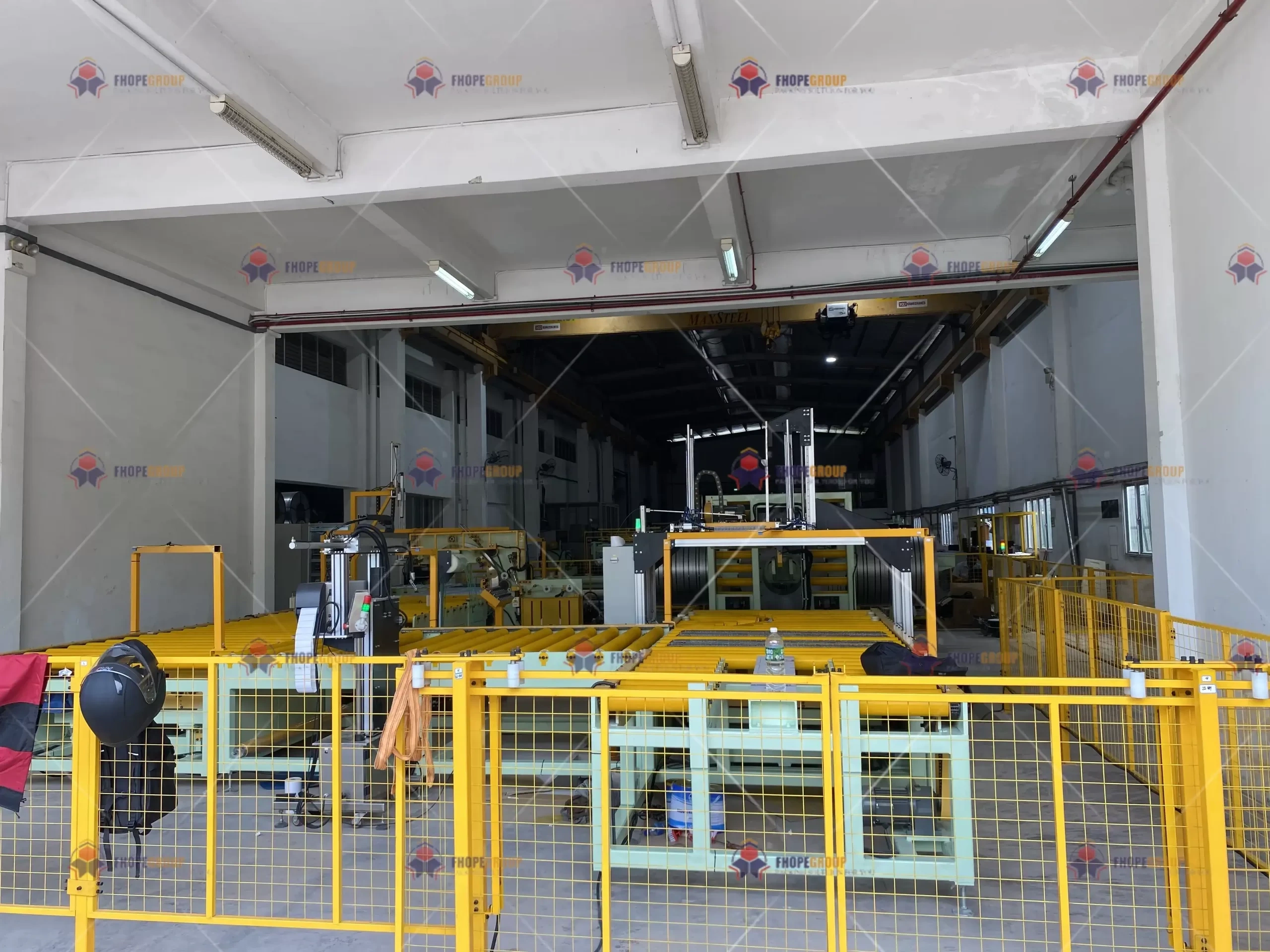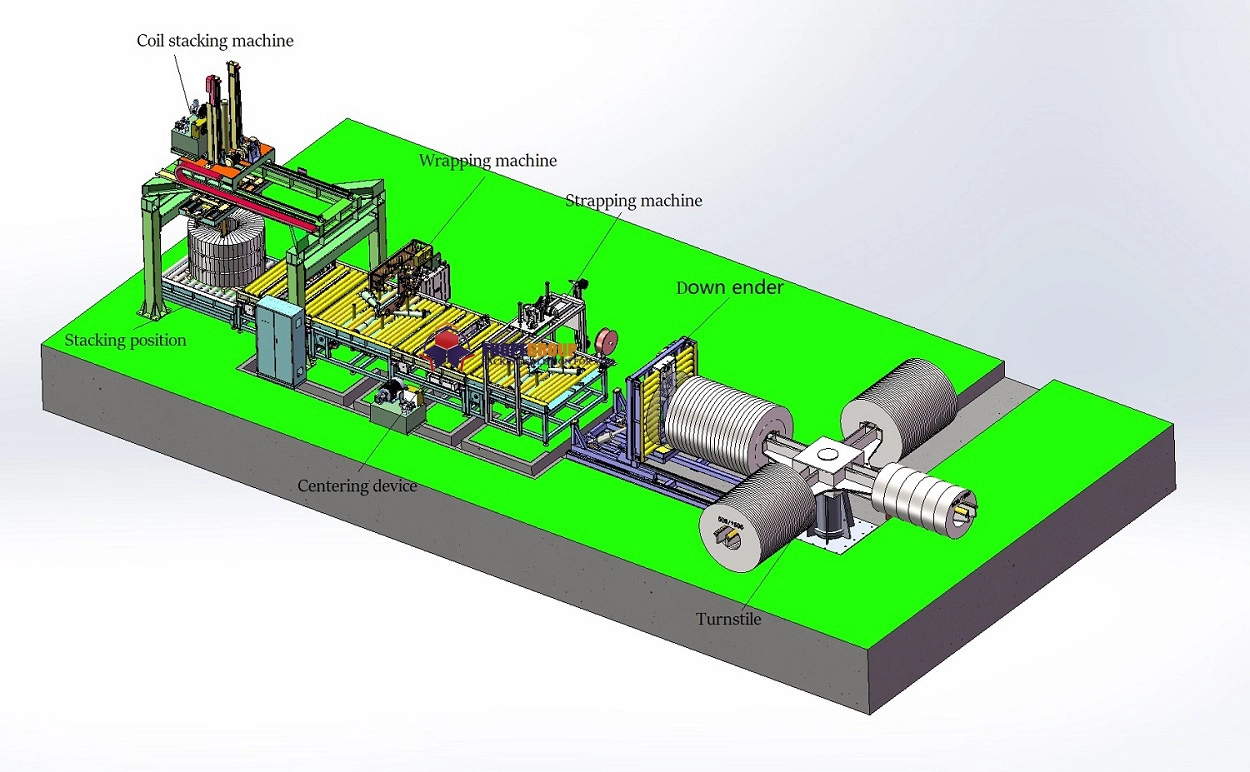A heavy steel coil slips during transfer, crushing a worker’s foot. A misaligned wrapper severs hydraulic lines, spraying fluid near ignition sources. These aren’t hypotheticals – they’re daily risks in coil packaging without rigorous safety protocols. Every year, preventable accidents cause injuries, costly downtime, and product damage. But what if your line could become an impenetrable fortress of safety? The solution lies in engineered safeguards, operator-centric design, and proactive damage control systems.

Ensuring secure coil packing operations requires integrating three pillars: operator protection systems (emergency stops, light curtains), mechanical failure prevention (sensor-guided alignment, torque limiters), and damage control protocols (anti-scratch coatings, impact monitoring). This holistic approach reduces workplace injuries by 60%, cuts product damage by 45%, and prevents $150k+ in annual downtime costs per line – verified through ISO 13849 safety audits and incident tracking.
Transitioning from reactive fixes to proactive safety transforms coil packaging from a hazard zone to a productivity hub. Let’s dissect how industry leaders implement these life-saving measures without compromising efficiency.
Operator Safety: Protecting Your Most Valuable Asset
Imagine an operator reaching into a running strapping machine to adjust a misaligned coil – a split-second decision risking permanent injury. Human error and fatigue contribute to 70% of packaging line accidents. How do we create fail-safes that guard against these inevitabilities?
Operator safety in coil packaging demands physical barriers, intelligent sensors, and ergonomic workflows. Light curtains halt machinery when breaches occur, emergency stop chains shut down entire lines within 0.5 seconds, and anti-fatigue platforms reduce slips. Studies show these measures lower incident rates by 80% while boosting productivity through reduced operator stress.

Engineering Human-Machine Harmony
Modern coil packing lines integrate layered protection systems starting with access control. RFID-tagged helmets prevent unauthorized entry into automated zones, while pressure-sensitive floors trigger shutdowns if operators stray beyond marked pathways. During threading or maintenance, dual-hand control systems require both hands on buttons – physically preventing limb access to pinch points.
Vibration and noise mitigation are equally critical. Coil transfer impacts generate 110dB+ peaks – equivalent to jet engines. Installing rubber-damped conveyors and acoustic enclosures reduces levels below 85dB, meeting OSHA standards while minimizing long-term hearing damage. Additionally, HMI interfaces feature simplified color-coded alerts:
- Red: Immediate danger (e.g., hydraulic pressure loss)
- Amber: Attention required (e.g., wrapper misalignment)
- Green: Normal operation
Ergonomic interventions further reduce risks. Adjustable workstations accommodate different heights, reducing back strain during manual strapping checks. Pneumatic coil rotators eliminate manual turning – a common cause of musculoskeletal injuries. Post-implementation audits at a German steel mill showed a 40% drop in ergonomic-related sick days.
Critical Safety Components Comparison:
| Safety Element | Function | Response Time | Failure Rate | Cost Impact |
|---|---|---|---|---|
| Light Curtains | Detects limb intrusion | < 20ms | 0.0001% | $8k-$15k |
| Emergency Stop Circuits | Full line shutdown | < 500ms | 0.001% | $3k-$7k |
| Torque Limiters | Prevents overload injuries | Instantaneous | 0.005% | $1k-$4k |
| Vibration Dampers | Reduces fatigue & slips | Continuous | N/A | $5k-$10k |
Packing Line Safety: Preventing Mechanical Failures
A single sensor malfunction can cascade into catastrophic failure: an unmonitored coil overloads a conveyor, snapping chains that whip through the enclosure. Mechanical failures cause 52% of unplanned downtime in packaging operations. What transforms these vulnerabilities into reliability?
Packing line safety hinges on predictive maintenance and failure-proof design. Vibration sensors detect bearing wear 3 weeks before failure, thermal cameras spot electrical hotspots, and PLC-controlled torque limiters prevent motor burnout. Implementing these measures slashes mechanical breakdowns by 75% and extends equipment lifespan by 4-7 years based on load cycles.

Smart Monitoring Architectures
Advanced coil lines employ IIoT-enabled vibration analysis with accelerometers mounted on critical components like wrapper turntables and transfer arms. Baseline signatures are established during commissioning, with AI algorithms flagging deviations exceeding 15% – triggering maintenance tickets before audible symptoms emerge. For example, a 28% vibration spike in a servo reducer alerted technicians to replace worn gears during scheduled downtime, avoiding a potential 36-hour stoppage.
Hydraulic systems – common failure points – incorporate pressure transducers and flow meters. If pressure drops 20% below setpoints during coil compression, sequences auto-abort to prevent under-clamping incidents. Temperature sensors on electrical cabinets initiate cooling if internal temps exceed 50°C (122°F), preventing insulation degradation.
Structural integrity is ensured through:
- Redundant Load Paths: Dual-chain conveyors maintain operation if one chain fails
- Overload Shear Pins: Sacrificial components break before major damage occurs
- Laser Alignment Systems: Ensure rollers stay parallel within 0.2mm tolerance
These protocols transformed operations at a Brazilian coil processor, reducing mechanical-related stoppages from 14 hours/month to under 2 hours within six months of implementation.
Damage Control: Minimizing Product and Equipment Loss
A 20-ton coil with scratched surfaces gets rejected – a $15,000 loss. A wrapper head collision with mispositioned steel requires $40k in repairs. Damage control isn’t just about protection; it’s about preserving profit margins through precision engineering.
Effective coil damage control combines surface protection technologies, collision avoidance systems, and AI-driven anomaly detection. Polyurethane-coated rollers prevent surface scratches, LiDAR scanners map coil positions within 1mm accuracy, and machine learning algorithms predict edge damage risks 48 hours in advance – reducing product rejection rates by 90% and equipment repair costs by 60%.

Precision Protection Protocols
Surface preservation begins at transfer points. Electrically conductive rubber rollers prevent static-induced markings, while self-lubricating UHMW polyethylene skids eliminate metal-to-metal contact. For premium finishes, vacuum-lifted coil turners avoid sling marks entirely. Post-packaging, moisture sensors inside wraps detect humidity spikes above 45% – triggering ventilation to prevent corrosion during transit.
Collision avoidance relies on multi-sensor verification:
- LiDAR: 3D mapping of coil position
- Ultrasonic Sensors: Verifying end-flange alignment
- Encoder Feedback: Confirming wrapper arm extension
If any sensor disagrees with PLC positioning commands by >2mm, movements halt. This prevented 17 potential collisions monthly in a Turkish galvanizing line.
Damage Control ROI Analysis (Per Line):
| Damage Type | Average Loss Without Controls | With Controls | Annual Savings | Implementation Cost |
|---|---|---|---|---|
| Surface Scratches | $18,000 | $1,800 | $16,200 | $7,500 |
| Edge Denting | $9,500 | $950 | $8,550 | $3,200 |
| Equipment Collisions | $42,000 | $16,800 | $25,200 | $22,000 |
| Moisture Damage | $6,000 | $600 | $5,400 | $4,000 |
| Total | $75,500 | $20,150 | $55,350 | $36,700 |
Implementing a Comprehensive Safety Strategy
A holistic coil packing safety strategy integrates risk assessments, layered technology, and cultural engagement. Conducting FMEA (Failure Mode Effects Analysis) identifies 92% of hazards pre-commissioning, while combining hardware safeguards with operator training reduces near-misses by 75%. This approach delivers ROI within 14 months through reduced insurance premiums and downtime savings.

Step-by-Step Safety Transformation
Phase 1: Hazard Mapping
Begin with digital twin simulations modeling worst-case scenarios:
- Coil drops during rotation
- Hydraulic hose bursts
- Control system failures
Quantify risks using ANSI B11.0 severity/probability matrices to prioritize interventions.
Phase 2: Technology Stack Integration
Deploy a unified safety PLC (e.g., Siemens Fail-Safe) connecting:
- Access Control: Key-operated mode selectors
- Machine Guards: Interlocked barriers with position validation
- Environmental Sensors: Oxygen monitors for enclosed spaces
- Emergency Systems: Mushroom stops with mechanical latching
Phase 3: Human Factor Engineering
Develop competency-based training with VR simulators recreating high-risk scenarios like jam clearing. Implement a "safety observation" program where operators log near-misses without penalty – yielding 30% more actionable data than traditional audits. Performance dashboards display real-time safety metrics alongside production KPIs, reinforcing that safety enables productivity.
Phase 4: Continuous Improvement
Embed IoT data streams into CMMS (Computerized Maintenance Management Systems) to correlate:
- Vibration spikes with guard removal incidents
- Temperature trends with component failures
- Cycle time delays with safety override usage
This closed-loop system helped a U.S. processor achieve 5 years without lost-time incidents while increasing throughput by 18%.
Conclusion
Securing coil packing operations demands more than compliance checklists – it requires a cultural and technological revolution. By fusing operator-centric safety systems with predictive mechanical safeguards and precision damage controls, facilities transform high-risk zones into models of efficiency. The data is unequivocal: plants implementing these integrated strategies reduce injury rates by 60%, slash product damage costs by 55%, and achieve ROI within 18 months through uninterrupted production. As coil weights increase and automation advances, this holistic approach to packing line safety becomes not just ethical, but economically indispensable. The question isn’t whether you can afford these measures – it’s whether you can afford the catastrophic costs of neglecting them.













Leave a Reply
You must be logged in to post a comment.